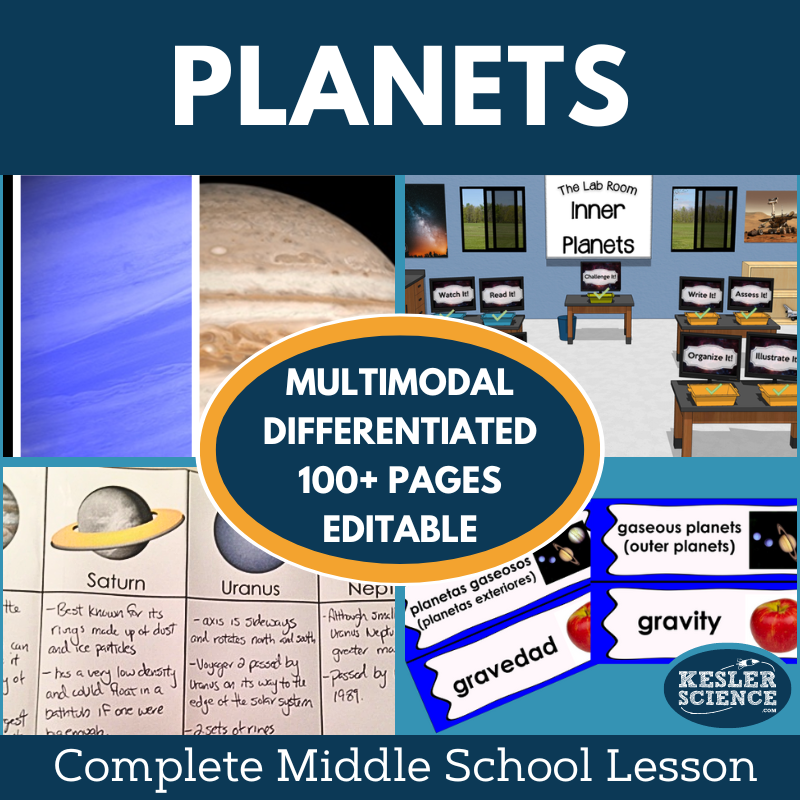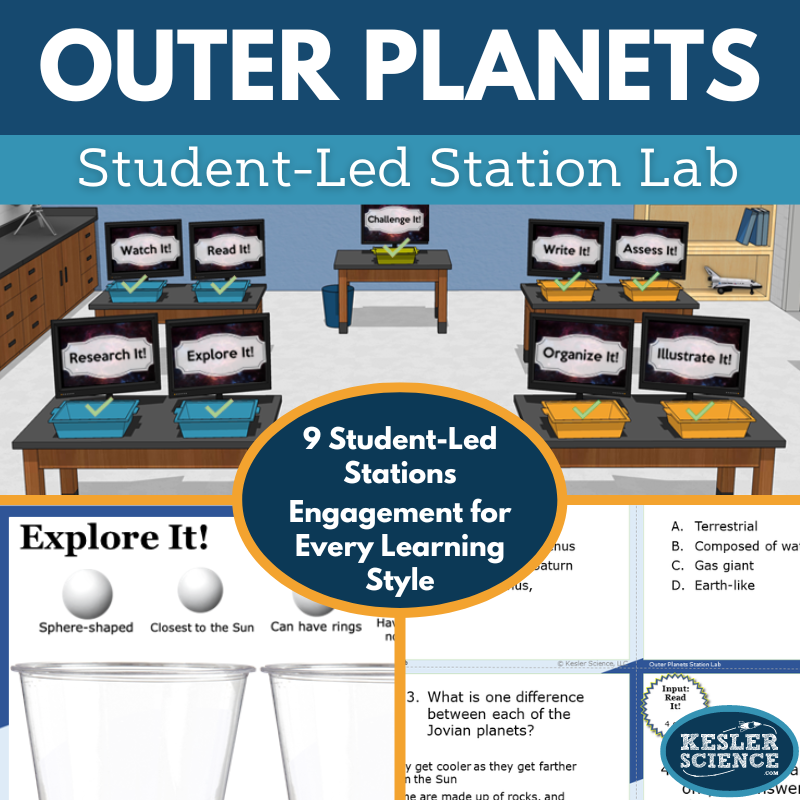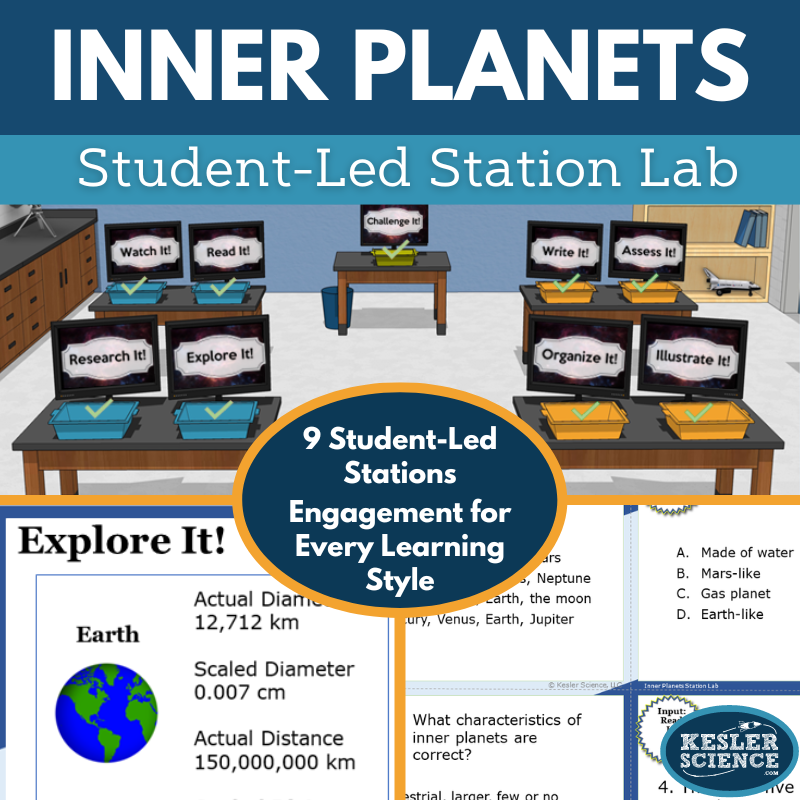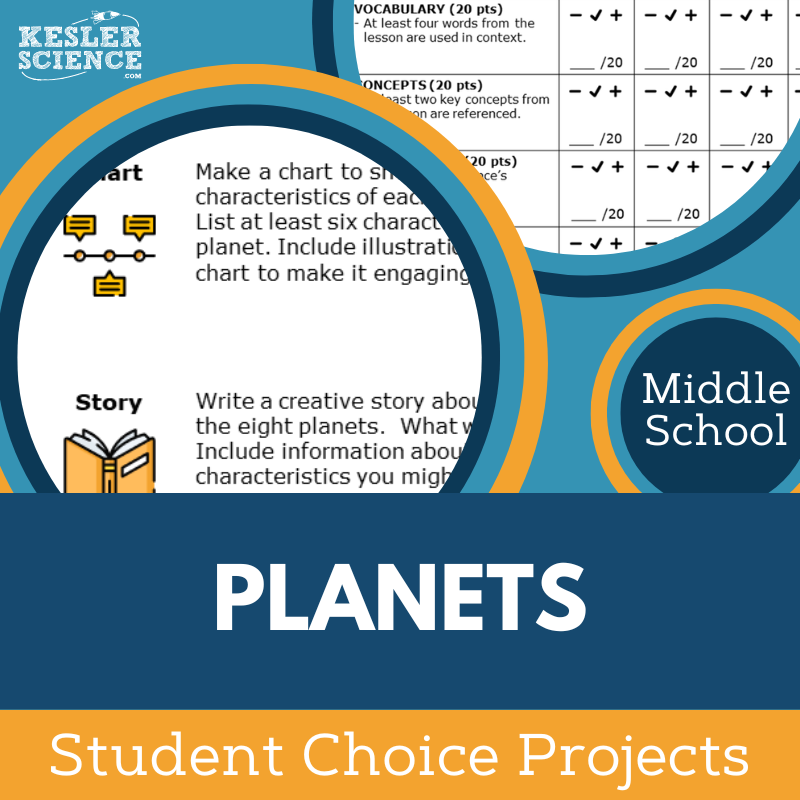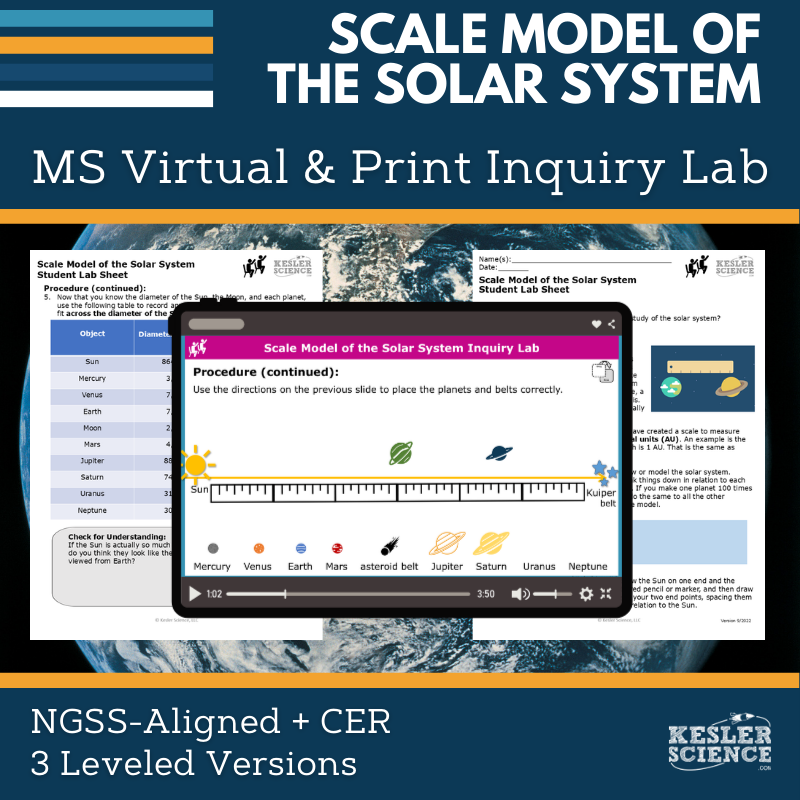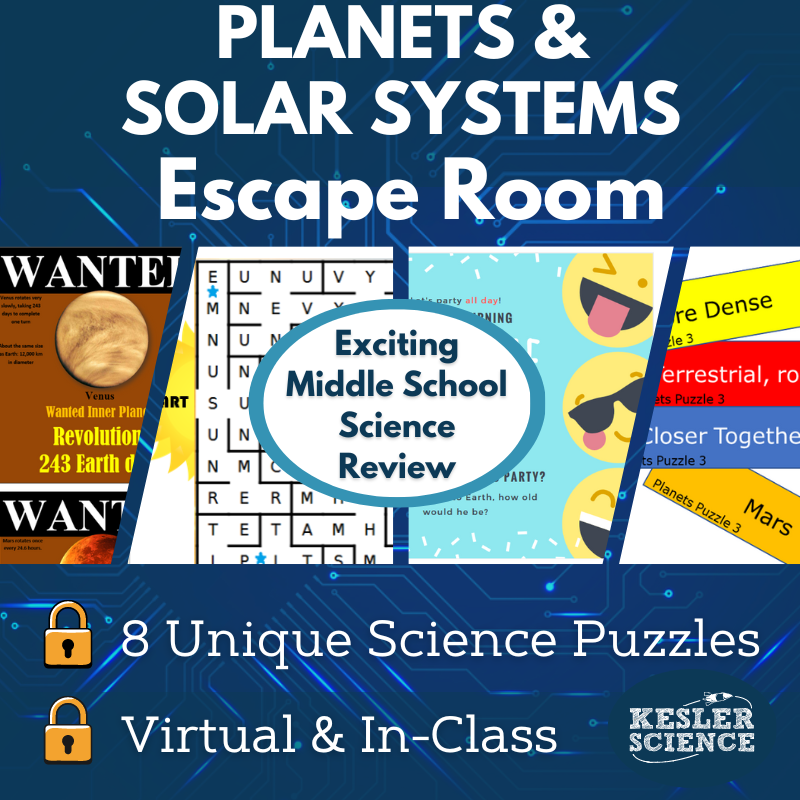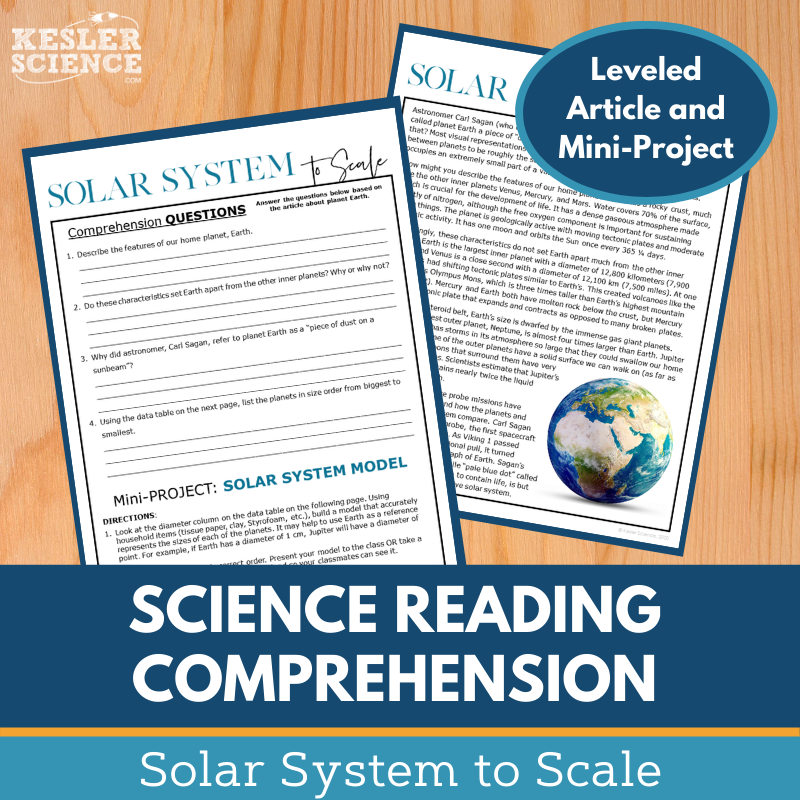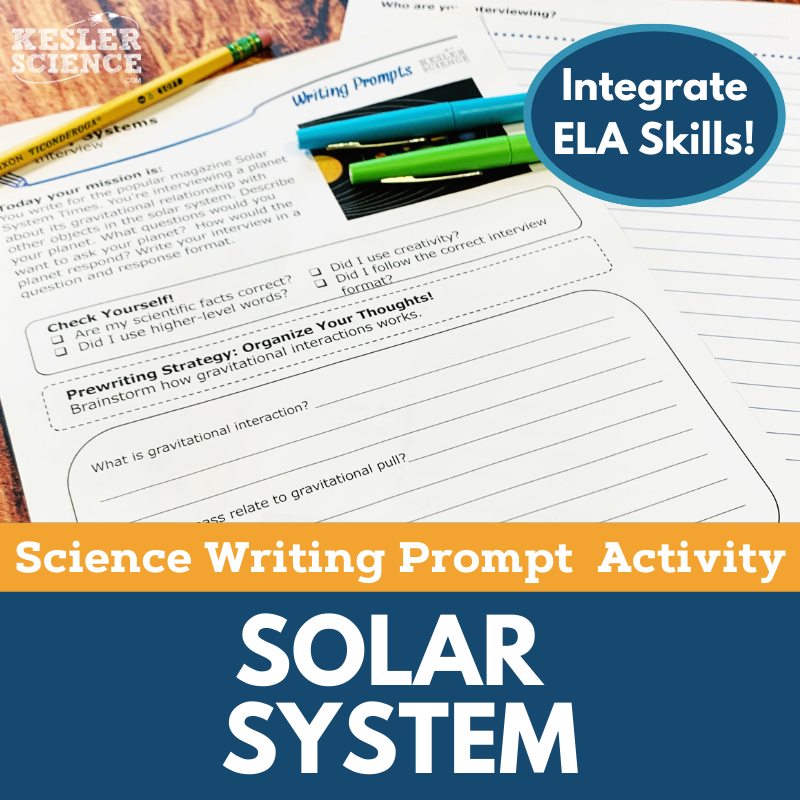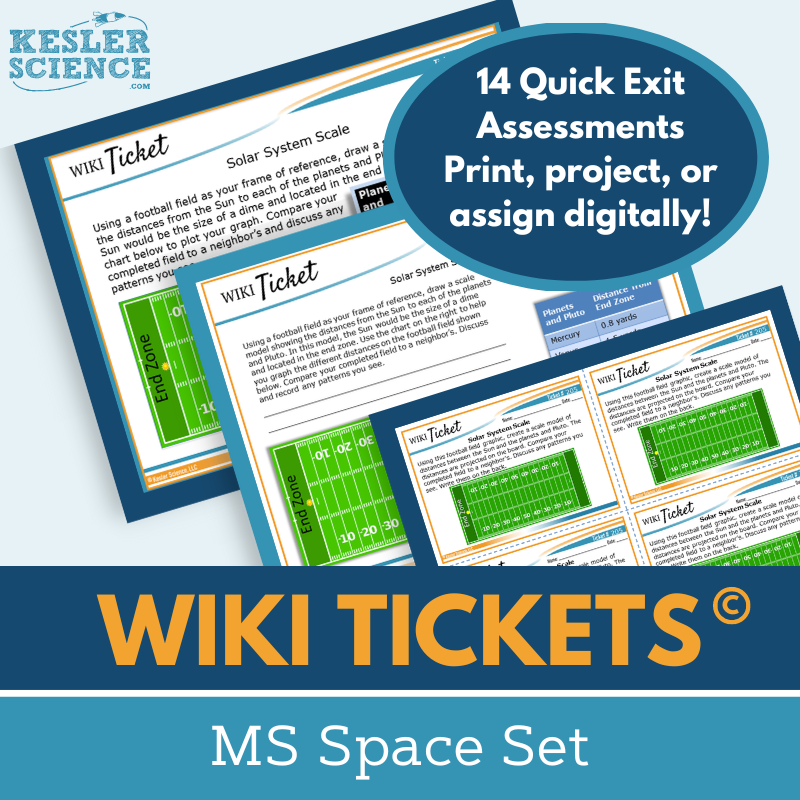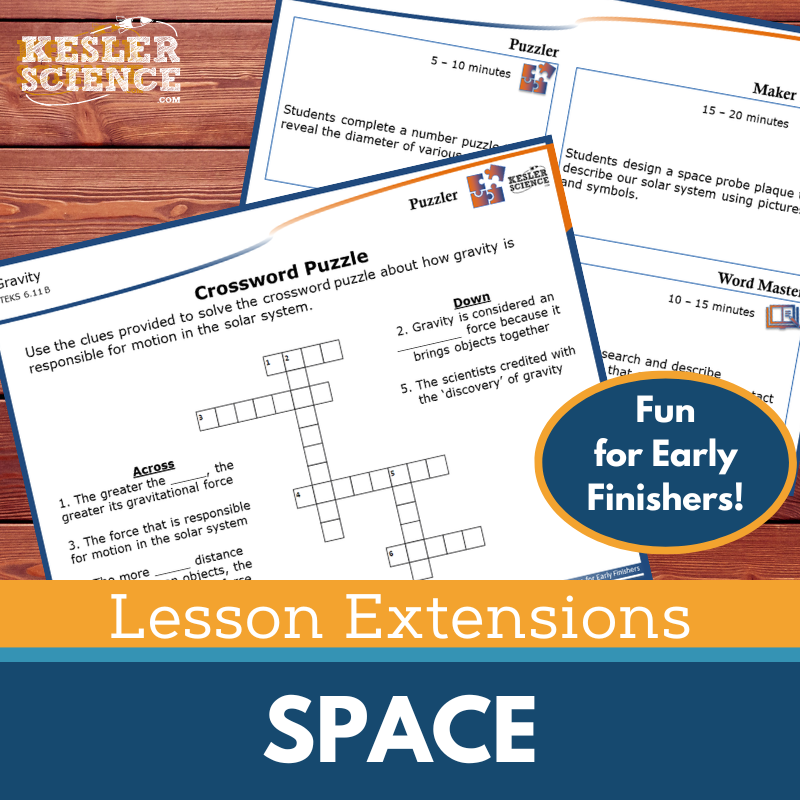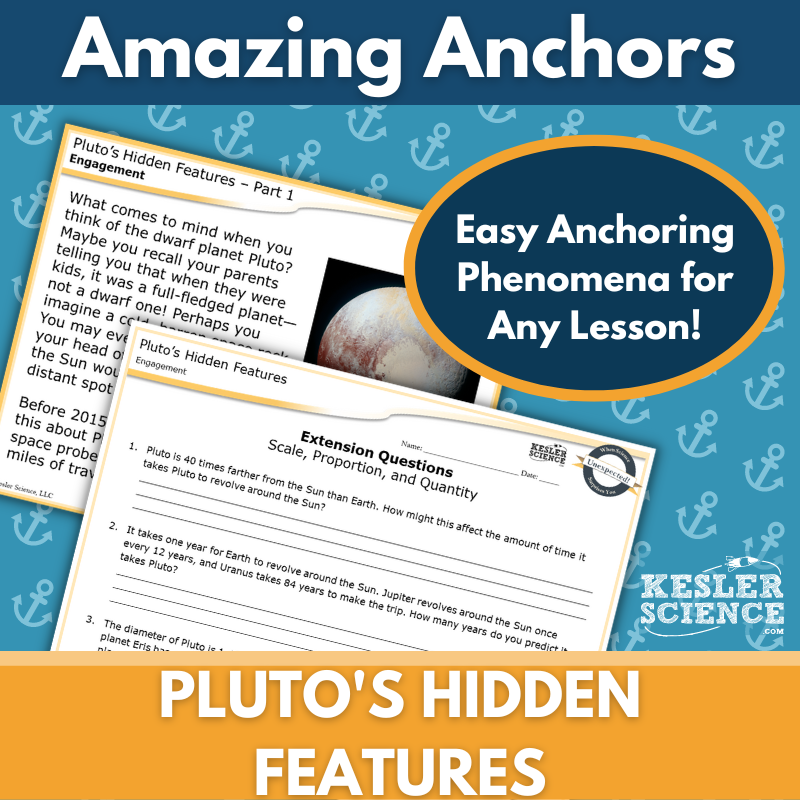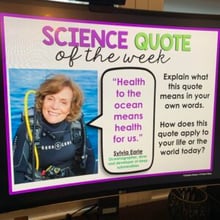Scale Model of the Solar System Activities for Middle School Science
Explore the characteristics and movements of inner and outer planets with this engaging middle school lesson. Designed for differentiated, student-led learning, it follows the 5E Model, guiding students through interactive engagement activities, a hands-on exploration station lab, and multimedia explanation materials like interactive PowerPoints and digital or print notebook templates. The resources below will give students a comprehensive understanding of the scale model of the solar system. All of the following materials are also included in the Kesler Science Membership.
The Kesler Science Planets (Inner & Outer) Complete Lesson on the characteristics and movements of inner and outer planets is a fully editable, engaging middle school unit designed for differentiated, student-led learning. It includes presentations, worksheets, choice projects, and assessments, all requiring minimal prep.
Students will explore key questions about planetary properties and movements through a 5E Model framework: engagement activities, a hands-on, multimodal exploration station lab, and explanation materials such as interactive PowerPoints and digital or print interactive notebook templates. The elaboration phase includes student-choice projects, while evaluation features STAAR 2.0-aligned assessments and review worksheets.
This lesson offers flexible formats, including printable and digital options, along with Spanish translations for vocabulary, reading passages, and notebook pages. It supports virtual learning, ensuring accessibility both in-class and online.
The Kesler Science Planets (Inner & Outer) Complete Lesson on the characteristics and movements of inner and outer planets is a fully editable, engaging middle school unit designed for differentiated, student-led learning. It includes presentations, worksheets, choice projects, and assessments, all requiring minimal prep.
Students will explore key questions about planetary properties and movements through a 5E Model framework: engagement activities, a hands-on, multimodal exploration station lab, and explanation materials such as interactive PowerPoints and digital or print interactive notebook templates. The elaboration phase includes student-choice projects, while evaluation features STAAR 2.0-aligned assessments and review worksheets.
This lesson offers flexible formats, including printable and digital options, along with Spanish translations for vocabulary, reading passages, and notebook pages. It supports virtual learning, ensuring accessibility both in-class and online.
Engage your middle school students with this student-led station lab on the outer planets, designed to explore how gravity governs the motion of our solar system. This modular, differentiated activity allows students to direct their own learning while teachers facilitate rather than instruct.
The lab includes nine interactive stations that encourage exploration through videos, readings, research, and hands-on activities. Input stations introduce new concepts through demonstrations, research tasks, reading passages in English and Spanish, and video analysis. Output stations allow students to demonstrate understanding by organizing information, illustrating models, writing responses, and completing assessments. A challenge station offers extension activities for early finishers.
This resource is designed for both in-class and virtual learning, providing a flexible and engaging way for students to deepen their understanding of planetary science.
Engage your middle school students with this student-led station lab on the outer planets, designed to explore how gravity governs the motion of our solar system. This modular, differentiated activity allows students to direct their own learning while teachers facilitate rather than instruct.
The lab includes nine interactive stations that encourage exploration through videos, readings, research, and hands-on activities. Input stations introduce new concepts through demonstrations, research tasks, reading passages in English and Spanish, and video analysis. Output stations allow students to demonstrate understanding by organizing information, illustrating models, writing responses, and completing assessments. A challenge station offers extension activities for early finishers.
This resource is designed for both in-class and virtual learning, providing a flexible and engaging way for students to deepen their understanding of planetary science.
Engage your middle school students with this student-led station lab on the inner planets. Designed for in-class or virtual learning, this interactive lesson helps students understand that gravity governs the motion of our solar system through nine differentiated stations featuring videos, readings, research, and hands-on activities.
Students demonstrate their learning by organizing information, illustrating models, writing responses, and completing assessments. A challenge station provides extension activities for early finishers. All stations include necessary signage, literature, and resources, with minimal additional materials needed.
This low-prep, high-engagement resource fosters independent learning and critical thinking, making it a valuable addition to your space science curriculum.
Engage your middle school students with this student-led station lab on the inner planets. Designed for in-class or virtual learning, this interactive lesson helps students understand that gravity governs the motion of our solar system through nine differentiated stations featuring videos, readings, research, and hands-on activities.
Students demonstrate their learning by organizing information, illustrating models, writing responses, and completing assessments. A challenge station provides extension activities for early finishers. All stations include necessary signage, literature, and resources, with minimal additional materials needed.
This low-prep, high-engagement resource fosters independent learning and critical thinking, making it a valuable addition to your space science curriculum.
The Planets Student Choice Projects lesson allows middle school students to select a project that matches their preferred output style. A project page outlines six student-led options plus a “design your own” project, with a grading rubric for teacher, peer, or self-assessment. These flexible, multimodal projects give students creative ways to demonstrate their understanding. Teachers can modify the rubric to fit their grading needs.
Two versions of the project page support differentiation, with a modified version offering targeted options for students needing remediation and opportunities for advanced learners to combine projects. The projects use standard classroom supplies like paper, markers, and scissors, with many options available for digital completion.
The Planets Student Choice Projects lesson allows middle school students to select a project that matches their preferred output style. A project page outlines six student-led options plus a “design your own” project, with a grading rubric for teacher, peer, or self-assessment. These flexible, multimodal projects give students creative ways to demonstrate their understanding. Teachers can modify the rubric to fit their grading needs.
Two versions of the project page support differentiation, with a modified version offering targeted options for students needing remediation and opportunities for advanced learners to combine projects. The projects use standard classroom supplies like paper, markers, and scissors, with many options available for digital completion.
The Scale Model of the Solar System Inquiry Lab aligns with NGSS MS-ESS1-3, guiding students to analyze and interpret data to understand scale properties of solar system objects. This lab offers both hands-on and digital interactive versions, each including comprehension questions, Claim-Evidence-Reasoning (C.E.R.) prompts, and reflection activities.
Students begin by hypothesizing about planetary distances from the Sun, then create a paper model. They analyze data, calculate distances, and determine planetary diameters to grasp why scientists use scaled drawings of the solar system.
The lab includes three differentiated levels—Dependent (guided inquiry), Modified (structured with supports), and Independent (student-led exploration). The digital version is fully interactive and compatible with Google Slides, MS Teams, Schoology, and Canvas, while the print format provides a hands-on experience with materials like calculators, butcher paper, and colored pencils.
Teacher resources include editable PowerPoints, answer keys, standards, objectives, and flexible formats to accommodate diverse learning needs.
The Scale Model of the Solar System Inquiry Lab aligns with NGSS MS-ESS1-3, guiding students to analyze and interpret data to understand scale properties of solar system objects. This lab offers both hands-on and digital interactive versions, each including comprehension questions, Claim-Evidence-Reasoning (C.E.R.) prompts, and reflection activities.
Students begin by hypothesizing about planetary distances from the Sun, then create a paper model. They analyze data, calculate distances, and determine planetary diameters to grasp why scientists use scaled drawings of the solar system.
The lab includes three differentiated levels—Dependent (guided inquiry), Modified (structured with supports), and Independent (student-led exploration). The digital version is fully interactive and compatible with Google Slides, MS Teams, Schoology, and Canvas, while the print format provides a hands-on experience with materials like calculators, butcher paper, and colored pencils.
Teacher resources include editable PowerPoints, answer keys, standards, objectives, and flexible formats to accommodate diverse learning needs.
The Planets Escape Room is an immersive, student-centered activity that lets students demonstrate their understanding of the characteristics of inner and outer planets in our solar system in a fun and engaging way. Aligned with NGSS standards MS-ESS1-2 and MS-ESS1-3, students explore gravity's role in planetary motions and analyze scale properties within the solar system.
Teachers have complete flexibility with eight independent puzzles, customizing the experience based on class time and instructional needs. The escape room can be set up simply with manila envelopes or authentically with locks, a lockout hasp, and storage boxes. Both setups require printed materials, envelopes, and metal brads, all provided within the resource.
A digital version suitable for single-student use via Google Slides or PowerPoint allows students to solve puzzles interactively, manipulating images and answering questions digitally. Additionally, a printable version is available for students to complete at home.
Included in this comprehensive resource are teacher instructions, detailed answer keys, editable versions of materials, a Google Form digital answer sheet, engaging video challenges, printable props, reward templates, prize suggestions, and editable signs to celebrate students' success. This interactive escape room is designed to keep students excited and engaged throughout their exploration of the solar system.
The Planets Escape Room is an immersive, student-centered activity that lets students demonstrate their understanding of the characteristics of inner and outer planets in our solar system in a fun and engaging way. Aligned with NGSS standards MS-ESS1-2 and MS-ESS1-3, students explore gravity's role in planetary motions and analyze scale properties within the solar system.
Teachers have complete flexibility with eight independent puzzles, customizing the experience based on class time and instructional needs. The escape room can be set up simply with manila envelopes or authentically with locks, a lockout hasp, and storage boxes. Both setups require printed materials, envelopes, and metal brads, all provided within the resource.
A digital version suitable for single-student use via Google Slides or PowerPoint allows students to solve puzzles interactively, manipulating images and answering questions digitally. Additionally, a printable version is available for students to complete at home.
Included in this comprehensive resource are teacher instructions, detailed answer keys, editable versions of materials, a Google Form digital answer sheet, engaging video challenges, printable props, reward templates, prize suggestions, and editable signs to celebrate students' success. This interactive escape room is designed to keep students excited and engaged throughout their exploration of the solar system.
This Solar System to Scale Science Reading Comprehension Lesson helps students explore the scale and characteristics of Earth and other planets through an engaging nonfiction article. Designed for middle school (grades 6–8, including advanced 5th graders), this resource strengthens science literacy and reading comprehension.
The lesson includes two leveled articles (Lexile levels 1100–1300), five to seven comprehension questions, and a hands-on, interactive mini-project where students create a solar system model. A Cornell notes template is provided to support structured note-taking. Engaging, colorful graphics enhance the materials and print well in grayscale.
This resource is versatile and suitable for both classroom and distance-learning environments, with files compatible with Google Classroom, MS Teams, Schoology, and Canvas. Students can conveniently respond directly within digital documents (provided as PPT or Google Slides).
Ideal for sub plans, extra credit, absent students, ISS, or whole-class instruction, this lesson encourages critical thinking, meaningful classroom discussions, and enhances students' textual analysis skills.
This Solar System to Scale Science Reading Comprehension Lesson helps students explore the scale and characteristics of Earth and other planets through an engaging nonfiction article. Designed for middle school (grades 6–8, including advanced 5th graders), this resource strengthens science literacy and reading comprehension.
The lesson includes two leveled articles (Lexile levels 1100–1300), five to seven comprehension questions, and a hands-on, interactive mini-project where students create a solar system model. A Cornell notes template is provided to support structured note-taking. Engaging, colorful graphics enhance the materials and print well in grayscale.
This resource is versatile and suitable for both classroom and distance-learning environments, with files compatible with Google Classroom, MS Teams, Schoology, and Canvas. Students can conveniently respond directly within digital documents (provided as PPT or Google Slides).
Ideal for sub plans, extra credit, absent students, ISS, or whole-class instruction, this lesson encourages critical thinking, meaningful classroom discussions, and enhances students' textual analysis skills.
The Solar System Science Writing Prompt Activity engages middle school students with an interactive travel brochure project designed to reinforce earth and space science concepts. Aligned with NGSS MS-ESS1-3, students analyze and interpret data to explore scale properties of objects within the solar system, enhancing their science reasoning and writing skills. This creative, low-prep activity is student-centered and adaptable for both classroom and virtual learning environments.
Included materials are teacher directions with an answer guide, project suggestions, rubrics, and printable handouts available in full-sized and half-sheet formats for interactive notebooks. A digital PowerPoint version, compatible with Google Slides, is provided for easy virtual use.
Ideal for cross-curricular integration, pre-test assessments, student choice projects, extra credit, differentiation, or enrichment for early finishers, these prompts are perfect for display on bulletin boards or compiling into student anthologies. Activities assume students have prior knowledge or access to research materials.
The Solar System Science Writing Prompt Activity engages middle school students with an interactive travel brochure project designed to reinforce earth and space science concepts. Aligned with NGSS MS-ESS1-3, students analyze and interpret data to explore scale properties of objects within the solar system, enhancing their science reasoning and writing skills. This creative, low-prep activity is student-centered and adaptable for both classroom and virtual learning environments.
Included materials are teacher directions with an answer guide, project suggestions, rubrics, and printable handouts available in full-sized and half-sheet formats for interactive notebooks. A digital PowerPoint version, compatible with Google Slides, is provided for easy virtual use.
Ideal for cross-curricular integration, pre-test assessments, student choice projects, extra credit, differentiation, or enrichment for early finishers, these prompts are perfect for display on bulletin boards or compiling into student anthologies. Activities assume students have prior knowledge or access to research materials.
These WIKI Tickets© Formative Assessments provide engaging, flexible ways to check student understanding in 6th-8th grade science. The Space Set includes 14 topics, each offered in five versatile formats: a full-screen projection version, three handout options (full, split, and quarter-page sizes), and an interactive digital version compatible with PowerPoint and Google Slides.
Aligned with NGSS and TEKS standards for middle school science, these assessments cover essential topics such as day, night, and seasons, the electromagnetic spectrum, lunar phases, solar system gravity, space exploration, and more. Ideal as exit tickets, bellringers, or quick checks, WIKI Tickets© can be used effectively both in-person and in virtual or distance-learning settings.
These WIKI Tickets© Formative Assessments provide engaging, flexible ways to check student understanding in 6th-8th grade science. The Space Set includes 14 topics, each offered in five versatile formats: a full-screen projection version, three handout options (full, split, and quarter-page sizes), and an interactive digital version compatible with PowerPoint and Google Slides.
Aligned with NGSS and TEKS standards for middle school science, these assessments cover essential topics such as day, night, and seasons, the electromagnetic spectrum, lunar phases, solar system gravity, space exploration, and more. Ideal as exit tickets, bellringers, or quick checks, WIKI Tickets© can be used effectively both in-person and in virtual or distance-learning settings.
Lesson Extensions provide engaging, student-choice activities designed to challenge early finishers and deepen their understanding of space science. These activities help fill downtime, reinforce critical thinking, and keep students engaged with rigorous yet enjoyable learning opportunities. Aligned with NGSS and TEKS space standards, they offer a structured way to extend learning beyond the core lesson.
Each extension includes four interactive components: Puzzler for problem-solving, Maker Space for hands-on STEAM activities, Tech Connection for digital demonstrations, and Word Master for creative writing. With teacher directions, answer keys, and both print and projection versions, these extensions are perfect for lesson wrap-ups, enrichment, or independent challenges.
Topics covered include the components of the universe, Earth-Moon-Sun interactions, gravity, space travel, the lunar cycle, and more. These extensions provide high-level, engaging resources that ensure students remain focused and learning at a deeper level.
Lesson Extensions provide engaging, student-choice activities designed to challenge early finishers and deepen their understanding of space science. These activities help fill downtime, reinforce critical thinking, and keep students engaged with rigorous yet enjoyable learning opportunities. Aligned with NGSS and TEKS space standards, they offer a structured way to extend learning beyond the core lesson.
Each extension includes four interactive components: Puzzler for problem-solving, Maker Space for hands-on STEAM activities, Tech Connection for digital demonstrations, and Word Master for creative writing. With teacher directions, answer keys, and both print and projection versions, these extensions are perfect for lesson wrap-ups, enrichment, or independent challenges.
Topics covered include the components of the universe, Earth-Moon-Sun interactions, gravity, space travel, the lunar cycle, and more. These extensions provide high-level, engaging resources that ensure students remain focused and learning at a deeper level.
This Amazing Anchors Phenomenon Lesson uses Pluto’s hidden feature to hook students into learning about the solar system. The resource begins with an introductory reading that includes comprehension and extension questions to spark curiosity and uncover prior knowledge. After instruction, students revisit the topic with an explanatory reading that breaks down the science behind Pluto and its place in the solar system. This second reading includes reinforcement questions that help solidify student understanding and extend learning.
Aligned with NGSS standard ESS1-3, this no-prep resource includes teacher directions, answer keys, editable materials, and multiple formats for flexible classroom use. Both print and digital versions are provided, along with a projection version for easy display. Differentiated readings support all learners with a modified version that includes sentence starters. Designed to bookend your main lesson, these readings work well during the Engagement and Elaborate phases of the 5E model.
This Amazing Anchors Phenomenon Lesson uses Pluto’s hidden feature to hook students into learning about the solar system. The resource begins with an introductory reading that includes comprehension and extension questions to spark curiosity and uncover prior knowledge. After instruction, students revisit the topic with an explanatory reading that breaks down the science behind Pluto and its place in the solar system. This second reading includes reinforcement questions that help solidify student understanding and extend learning.
Aligned with NGSS standard ESS1-3, this no-prep resource includes teacher directions, answer keys, editable materials, and multiple formats for flexible classroom use. Both print and digital versions are provided, along with a projection version for easy display. Differentiated readings support all learners with a modified version that includes sentence starters. Designed to bookend your main lesson, these readings work well during the Engagement and Elaborate phases of the 5E model.
Year-Round Resources
These year-round activities will increase your students' understanding of many middle school science topics. All of these activities are also included in the Kesler Science Membership.
Visual Data & Graphing
You're not alone if your students struggle with understanding graphs, charts, and tables. It's a skill that takes an enormous amount of practice. This resource will help students build a strong foundation in analyzing data and creating their own data visualizations.
Bell Ringers and Warm-Ups
These middle school science bell ringers are an excellent way to engage your students as soon as they walk into your classroom. This comprehensive FULL YEAR resource includes everything you need to start off each science class with an interesting warm-up activity.
Review Board Games
Each game board has been carefully designed to keep students engaged. There are 10 different action spaces on each board and dozens of question cards. All of the actions are related to science concepts and keep the students motivated throughout the game.
Each game is ready to play. Simply print out the board and the cards and let the students enjoy reviewing nine different units.
Essential Questions and Standards
Below are the essential questions and standards associated with the lessons and activities included in the scale model of the solar system unit. This topic is only one of more than 100 middle school science topics included in the Kesler Science Membership.
-
Can you describe the physical properties of planets and their location?
-
Can you describe the movements of the Sun, the planets and the Galilean moons?
-
NGSS - MS-ESS1-3 Scale Model of the Solar System
Kesler Science Membership
Imagine never having to search for another middle school science lesson again. The membership gives you access to ALL of the Kesler Science products in one place (Yes, including everything above).
Say goodbye to long hours of lesson prep.

